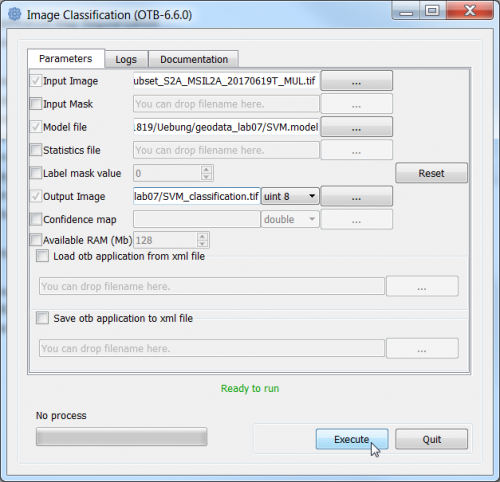Supervised classification (Tutorial)
From AWF-Wiki
(Difference between revisions)
(→Classification) |
(→Training per-pixel classifiers) |
||
| Line 6: | Line 6: | ||
* In the {{button|text=Input Vector Data List}} choose a vector polygon file with training areas: '''lab07_training_input.shp'''. | * In the {{button|text=Input Vector Data List}} choose a vector polygon file with training areas: '''lab07_training_input.shp'''. | ||
* Activate the checkbox {{button|text=Validation Vector Data List}} and choose a vector polygon file with an independent sample of validation areas: '''lab07_validation_input.shp''' | * Activate the checkbox {{button|text=Validation Vector Data List}} and choose a vector polygon file with an independent sample of validation areas: '''lab07_validation_input.shp''' | ||
| − | * In the {{button|text=Output model}} specify an output model file: e.g. ''' | + | * In the {{button|text=Output model}} specify an output model file: e.g. '''SVM.model''' |
* Activate the checkbox and save the {{button|text=Output confusion matrix or contingency table}} as '''ConfusionMatrixSVM.csv'''. | * Activate the checkbox and save the {{button|text=Output confusion matrix or contingency table}} as '''ConfusionMatrixSVM.csv'''. | ||
* In the {{button|text=Bound sample number by minimum}} field type {{typed|text=0}}. | * In the {{button|text=Bound sample number by minimum}} field type {{typed|text=0}}. | ||
| Line 12: | Line 12: | ||
* Set {{button|text=Field containing the class integer label}} to ''C_ID'' (C_ID refers to the column that contains the LUC code in the training and validation vector file). | * Set {{button|text=Field containing the class integer label}} to ''C_ID'' (C_ID refers to the column that contains the LUC code in the training and validation vector file). | ||
* Choose {{button|text=LibSVM classifier}} from the drop down list as Classifier to use for the training. | * Choose {{button|text=LibSVM classifier}} from the drop down list as Classifier to use for the training. | ||
| − | * The | + | * The SVM Kernel Type is {{button|text=Gaussian radial basis function}}. |
* Switch the Parameters optimization to {{button|text=on}}. | * Switch the Parameters optimization to {{button|text=on}}. | ||
* Set user defined seed with an integer value. | * Set user defined seed with an integer value. | ||
Revision as of 18:40, 8 December 2018
Classification with Orfeo Toolbox
Training per-pixel classifiers
- Type into the search box of the Windows taskbar: mapla.bat. Click on mapla.bat to open Monteverdi Application Launcher.
- In the search engine of mapla, type TrainImages and double click TrainImagesClassifer.
- In the Input Image List click on + and select a (or optional: several) multispectral images: Subset_S2A_MSIL2A_20170619T_MUL.tif .
- In the Input Vector Data List choose a vector polygon file with training areas: lab07_training_input.shp.
- Activate the checkbox Validation Vector Data List and choose a vector polygon file with an independent sample of validation areas: lab07_validation_input.shp
- In the Output model specify an output model file: e.g. SVM.model
- Activate the checkbox and save the Output confusion matrix or contingency table as ConfusionMatrixSVM.csv.
- In the Bound sample number by minimum field type 0.
- Set the training and validation sample ratio to 0. (0 = all training data).
- Set Field containing the class integer label to C_ID (C_ID refers to the column that contains the LUC code in the training and validation vector file).
- Choose LibSVM classifier from the drop down list as Classifier to use for the training.
- The SVM Kernel Type is Gaussian radial basis function.
- Switch the Parameters optimization to on.
- Set user defined seed with an integer value.
- Click on Execute.
Classification
- In the search engine of mapla, type ImageClassifier and double click ImageClassifier
- Set Subset_S2A_MSIL2A_20170619T_MUL.tif as Input image.
- Set SVM.model as Model file.
- Save the Output image as svm_classification.tif.
- Evaluate classification results:
- Load the multispectral Sentinel-2 image Subset_S2A_MSIL2A_20170619T_MUL.tif into QGIS.
- Data source Manager --> Browser --> XYZ Tiles. Select Google Satellite as background layer.
- Load the European Urban Atlas as vector layer D:\user\hfuchs\qgis1819\Uebung\geodata_lab01\vector\DE021L1_GOTTINGEN\ Subset-Goe_DE021L1_GOTTINGEN_UA2012_UTM32N.shp
- Add svm_classification.tif to the QGIS project.
- Download the style file classifcation.qml from Stud.IP.
- Right click svm_classifcation.tif in the TOC and select Properties --> Style --> Style --> Load Style.
- Select the style file classification.qml. OK
